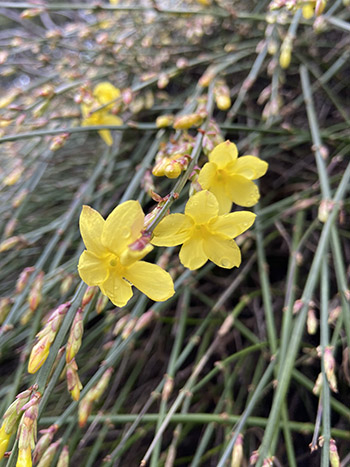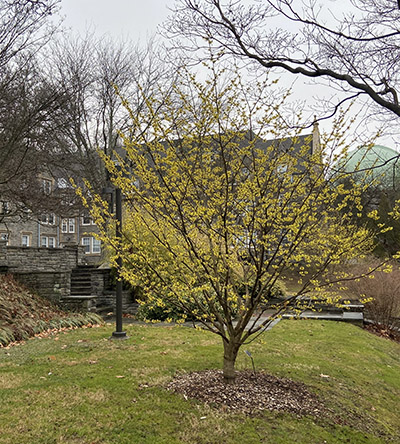
Plants of the Week: Jan. 16

Jasminum nudiflorum (winter jasmine)
Are you feeling down about the gray days, low-lying clouds, and this wet but warm weather we are having? If so, I’ve got the plant for you! Sunny yellow, graceful in its cascading form, and full of flowers, the Jasminum nudiflorum can brighten up those mid-January days. Native to northern China, this plant is often called “Yingchun” which means “flowers that welcome spring” and it certainly is welcoming me into a brighter mood.
Growing on the stone retaining wall between Pearson and Trotter Hall, this beautiful vine-like shrub cascades over the stone wall creating lovely downward movement in a waterfall effect. The cane-like stems are attractive green year round and are especially prominent in the winter months when the leaves have gone. In mid- to late-winter, non-fragrant, bright yellow flowers bloom along the stems before leaves arrive, dotting this beautifully formed shrub with highlights of color.
Flowering best with full sun, this Zone 6-10 plant prefers regular moisture in well-drained soils. It can become a little bit messy if unpruned and can be easily shaped in the spring once flowering has completed. Winter jasmine can be utilized in a variety of locations whether it is grown as a groundcover for slopes and banks, and on a terrace or stone wall as a trailing vine. Photo credit: M. Rossman

Hamamelis mollis ‘Wisley Supreme’ (Chinese witchhazel)
Another winter day, another witchhazel. The Hamamelis that is currently catching my eye is located on the banks below the Wharton Hall courtyard; one on either side of the pathway, creating a beautifully balanced scene in vibrant yellow. These Hamamelis mollis ‘Wisley Supreme’ specimens are hard to miss in the landscape.
Absolutely glowing, these fantastically fragrant Chinese witchhazels are in full bloom lasting through to early March. With a height and spread range of 10-15 feet, this is a fantastic specimen for a space where you want a pop of color with a medium sized tree. Best suited in locations with medium moisture and well-drained soils, the Hamamelis mollis ‘Wisley Supreme’ will flower best in full sun.
This cultivar originated at the Royal Horticultural Society’s Wisley Garden near London and is noted for its sweetly-scented, pale yellow flowers which are tinged with red at the petal base. Flowers are weather dependent and will unfurl their spidery petals on mild days but on cold days curl back up again to prevent them from freezing damage. Photo credit: M. Rossman

Prunus mume ‘Fragrant Snow’ (Japanese apricot)
My first encounter with a Japanese apricot was in the Scott Arboretum hoop house where we keep all our potted plants during the winter. I walked in inspecting what plants needed to be watered and was shocked to see the most beautiful pink blossoms on skeleton-like branches. I was surprised to see such beauty in the early days of January. A few days later I was on my typical walk to work when I encountered another Japanese apricot, Prunum mume ‘Fragrant Snow’ on the slope below the McCabe Library.
This tree has beautiful double white blossoms that are highly fragrant. Best flowering in full sun, ‘Fragrant Snow’ is a vigorous and early-blooming Japanese apricot that is fast-growing, with a handsome upright, rounded form. Flowers are followed by fuzzy-skinned, green to yellow apricots about 1 inch in diameter with clinging stones. The apricots ripen over the summer and are technically edible but are incredibly bitter and not pleasant to eat off the tree. In its native regions of China, Taiwan, Korea, and Japan, the fruits of the Prunus mume are picked in May through June and play an important role in food culture, where they are made into jams, syrups, and concentrates. Photo credit: M. Rossman





No Comments